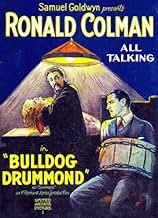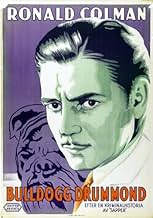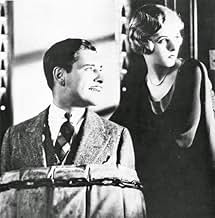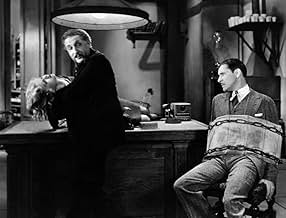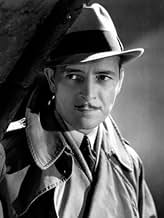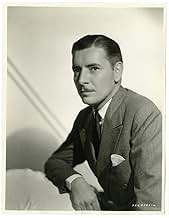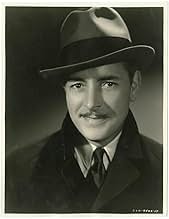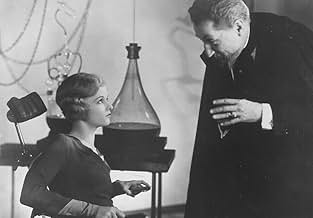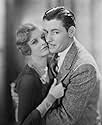IMDb RATING
6.3/10
1.4K
YOUR RATING
A bored WWI veteran helps out a young woman whose uncle is being held hostage by embezzlers.A bored WWI veteran helps out a young woman whose uncle is being held hostage by embezzlers.A bored WWI veteran helps out a young woman whose uncle is being held hostage by embezzlers.
- Director
- Writers
- Stars
- Nominated for 2 Oscars
- 5 wins & 2 nominations total
Claud Allister
- Algy
- (as Claude Allister)
Bill Johnson
- Little Boy
- (uncredited)
Tom Ricketts
- Colonel in Club
- (uncredited)
- Director
- Writers
- All cast & crew
- Production, box office & more at IMDbPro
Featured reviews
The year 1929 was a pivotal year in Hollywood for the talkie with a great rise in the percentage of all talking pictures and a slowdown on silents. Ronald Coleman, a box office star in silent pictures, makes his talking debut. Audiences of the day were pleased with his wonderfully cultured English. Also giving great support is Claude Allister as his wealthy society friend Algy. Joan Bennett in her film debut at age 18 shows her inexperience, though her lines are not much to work with, and Lawrence Grant as the evil Dr. Lackington hams it up like John Barrymore and delivers his lines at the slow and deliberate pace of Bela Lugosi.
Captain Hugh "Bulldog" Drummond is a wealthy retired office of the British army who yearns for another war to fight. Like Bruce Wayne (Batman), he wants to use his skills to help those in need. He answers the call to meet Joan Bennett at the Green Bay Inn and finds out that her father is being held against his will and tortured at a nursing home run by the evil Dr. Lackington (Grant). Montague Love is Dr. Lackington's strong man. In one very funny scene Love goes to the Green Bay Inn to catch Drummond. An Irish tenor has been singing and playing his accordion all evening. Love and a crony toss him out the door with his accordion making glissandos as it exits with him.
Drummond has a stable of cars of which two are shown in the film. The one he chooses to drive is a Mercedes SSK (the Excalibur is a copy of it). He drives it at night with the top down wearing a hat, scarf, and trench coat. Algy and his valet are always nearby following him in his Rolls Royce!
This movie might seem crude by today's standards, but judging it in the context of its time, it is far more entertaining than the poor musicals or slow boring adaptations of plays that the talkies usually featured during this era. Compare it with "The Great Gabbo" also released that year or "Annie Christie" , Garbo's first talkie released in 1930, and you'll see what I mean. In my opinion it's the best talkie prior to "All Quiet on the Western Front", which was filmed in 1929 and released the following year and went on to win "Best Picture".
Captain Hugh "Bulldog" Drummond is a wealthy retired office of the British army who yearns for another war to fight. Like Bruce Wayne (Batman), he wants to use his skills to help those in need. He answers the call to meet Joan Bennett at the Green Bay Inn and finds out that her father is being held against his will and tortured at a nursing home run by the evil Dr. Lackington (Grant). Montague Love is Dr. Lackington's strong man. In one very funny scene Love goes to the Green Bay Inn to catch Drummond. An Irish tenor has been singing and playing his accordion all evening. Love and a crony toss him out the door with his accordion making glissandos as it exits with him.
Drummond has a stable of cars of which two are shown in the film. The one he chooses to drive is a Mercedes SSK (the Excalibur is a copy of it). He drives it at night with the top down wearing a hat, scarf, and trench coat. Algy and his valet are always nearby following him in his Rolls Royce!
This movie might seem crude by today's standards, but judging it in the context of its time, it is far more entertaining than the poor musicals or slow boring adaptations of plays that the talkies usually featured during this era. Compare it with "The Great Gabbo" also released that year or "Annie Christie" , Garbo's first talkie released in 1930, and you'll see what I mean. In my opinion it's the best talkie prior to "All Quiet on the Western Front", which was filmed in 1929 and released the following year and went on to win "Best Picture".
When the first "Bulldog Drummond" stories came out in the 1920s, Great Britain was trying to come to grips with an anomaly: it had been one of the main allied victors in the Great War but the country did not feel like it won anything. It felt it had sacrificed too much.
Britain in 1914 had ruled the waves. It had a small (but apparently competent) standing army. It had a history of democracy that was stable and unmatched by any of the major continental powers of Europe. It had a very highly industrial economy and was commercially quite important on the globe. Finally, it's empire stretched around the world that the boast that "the sun never set on the British Empire" was true - it was also the world's largest empire.
In truth Britain's empire was actually wearing away. Though the British technically won the Boer War Boer Leaders ended up running South Africa. Ireland was getting hotter. The Germans helped stimulate the Easter Rebellion with arms. The British Navy did control the seas but the u-boats almost beat Britain during the war. The naval battles were marred by a total German triumph under Von Spee in the Pacific (Coronel)and the lopsided British ship and men losses at their "victory" at Jutland. Finally, Germany and the U.S. had outstripped British commerce and industrial output by 1914.
With the huge losses of a generation of men, and no tangible gains, Britain was in for a serious period of reactionary feelings and even race baiting. Anti-Semitism (always under the surface) reemerged in the 1920s, mostly due to the rise of Bolshevism in Russia after the 1917 revolutions. The political landscape did not reduce this hysteria. Lloyd George was booted out of the Prime Minister's seat forever in 1922. His successor, Andrew Bonar Law, died after nine months in office. Stanley Baldwin was not fully ready to be Prime Minister in 1923, and would blow his administration by a public hissy fit. His rival, James Ramsay MacDonald, would be the first Labor Prime Minister. But he'd been an outspoken pacifist in the war, and he was suspect of Bolshevistic sympathies (he actually had none). In the 1924 General Election a forged letter (supposedly from Gregory Zinovieff, the head of the Russian Comintern) urged MacDonald's election as an agent of the Russians. Baldwin regained office with a large majority.
It is this background that explains the popularity of "Bulldog Drummond". With governmental drift and doldrums, a declining economy, a feeling of loss of face on the international scene, and a feeling of loss due to immense death toll, the search for easy answers, easy suspects, easy enemies was ready for Sapper's poison. So the public cheered Col. Hugh "Bulldog" Drummond as he created a fascistic group of ex soldiers (like the German Freikorps) to "control" the internal enemy (i.e., Bolsheviks, Jews, Irish). I might add this was not totally made up. Lloyd George gave the go ahead while Prime Minister to create a paramilitary group in Ireland, the "Black and Tans", to combat the Irish revolutionaries. This group was finally decimated by Michael Collins' men on "Bloody Sunday" in 1921.
That Samuel Goldwyn, a Jewish American film producer, produced BULLDOG DRUMMOND, is highly ironic. But it illustrates the care Goldwyn brought to his projects. He had been producing the silent film hits that Ronald Colman appeared in in the late 1920s. Goldwyn wanted Colman to make the transition to sound carefully, and not fall on his face like Colman's rival John Gilbert. Instead of "Darling, I love you!" in HIS GLORIOUS NIGHT, Goldwyn found an exciting adventure part for Colman, which allowed him to display his wonderful, gentleman's speaking voice. As an introduction for a talking Colman, BULLDOG DRUMMOND could not be beaten.
The role had everything to show Colman's versatility. There was his humor, shown at the beginning when he is dismayed at the ridiculously boring men's club he belongs to (full of old fogies). There was his romantic side, with the youthful Joan Bennett. There is his confrontations with the sinister Lawrence Grant (Dr. Lakington) and Grant's two assistants Montague Love and Lilyan Tashman (Carl Peterson and Irma), and his handling of his impossibly stupid friend Algy (Claude Allister). As a "coming out" role for talkies, BULLDOG DRUMMOND did the trick, winning Colman the audience he feared talking films would cost him.
In terms of plot it creaks, with incredible coincidences and twists that allow plot points to fall apart for the creation of new plot points. Still the cast is game, and the script surprises us. Lakington, briefly having Drummond tied up, is speaking to him pretty closely. Colman turns his face from Grant, who accuses him of being more cowardly than he'd admit. Colman rejects this excuse. Then why turn your face away, demands Grant. "Haven't your best friends told you?", says Colman, leaving Grant turning crimson at the thought of halitosis. A later bit of business, allowing Love and Tashman to escape is also unexpected. Yes, it is an antique, but it is a charming one. And as it has none of Sapper's racist crap in it, it is highly recommended.
Britain in 1914 had ruled the waves. It had a small (but apparently competent) standing army. It had a history of democracy that was stable and unmatched by any of the major continental powers of Europe. It had a very highly industrial economy and was commercially quite important on the globe. Finally, it's empire stretched around the world that the boast that "the sun never set on the British Empire" was true - it was also the world's largest empire.
In truth Britain's empire was actually wearing away. Though the British technically won the Boer War Boer Leaders ended up running South Africa. Ireland was getting hotter. The Germans helped stimulate the Easter Rebellion with arms. The British Navy did control the seas but the u-boats almost beat Britain during the war. The naval battles were marred by a total German triumph under Von Spee in the Pacific (Coronel)and the lopsided British ship and men losses at their "victory" at Jutland. Finally, Germany and the U.S. had outstripped British commerce and industrial output by 1914.
With the huge losses of a generation of men, and no tangible gains, Britain was in for a serious period of reactionary feelings and even race baiting. Anti-Semitism (always under the surface) reemerged in the 1920s, mostly due to the rise of Bolshevism in Russia after the 1917 revolutions. The political landscape did not reduce this hysteria. Lloyd George was booted out of the Prime Minister's seat forever in 1922. His successor, Andrew Bonar Law, died after nine months in office. Stanley Baldwin was not fully ready to be Prime Minister in 1923, and would blow his administration by a public hissy fit. His rival, James Ramsay MacDonald, would be the first Labor Prime Minister. But he'd been an outspoken pacifist in the war, and he was suspect of Bolshevistic sympathies (he actually had none). In the 1924 General Election a forged letter (supposedly from Gregory Zinovieff, the head of the Russian Comintern) urged MacDonald's election as an agent of the Russians. Baldwin regained office with a large majority.
It is this background that explains the popularity of "Bulldog Drummond". With governmental drift and doldrums, a declining economy, a feeling of loss of face on the international scene, and a feeling of loss due to immense death toll, the search for easy answers, easy suspects, easy enemies was ready for Sapper's poison. So the public cheered Col. Hugh "Bulldog" Drummond as he created a fascistic group of ex soldiers (like the German Freikorps) to "control" the internal enemy (i.e., Bolsheviks, Jews, Irish). I might add this was not totally made up. Lloyd George gave the go ahead while Prime Minister to create a paramilitary group in Ireland, the "Black and Tans", to combat the Irish revolutionaries. This group was finally decimated by Michael Collins' men on "Bloody Sunday" in 1921.
That Samuel Goldwyn, a Jewish American film producer, produced BULLDOG DRUMMOND, is highly ironic. But it illustrates the care Goldwyn brought to his projects. He had been producing the silent film hits that Ronald Colman appeared in in the late 1920s. Goldwyn wanted Colman to make the transition to sound carefully, and not fall on his face like Colman's rival John Gilbert. Instead of "Darling, I love you!" in HIS GLORIOUS NIGHT, Goldwyn found an exciting adventure part for Colman, which allowed him to display his wonderful, gentleman's speaking voice. As an introduction for a talking Colman, BULLDOG DRUMMOND could not be beaten.
The role had everything to show Colman's versatility. There was his humor, shown at the beginning when he is dismayed at the ridiculously boring men's club he belongs to (full of old fogies). There was his romantic side, with the youthful Joan Bennett. There is his confrontations with the sinister Lawrence Grant (Dr. Lakington) and Grant's two assistants Montague Love and Lilyan Tashman (Carl Peterson and Irma), and his handling of his impossibly stupid friend Algy (Claude Allister). As a "coming out" role for talkies, BULLDOG DRUMMOND did the trick, winning Colman the audience he feared talking films would cost him.
In terms of plot it creaks, with incredible coincidences and twists that allow plot points to fall apart for the creation of new plot points. Still the cast is game, and the script surprises us. Lakington, briefly having Drummond tied up, is speaking to him pretty closely. Colman turns his face from Grant, who accuses him of being more cowardly than he'd admit. Colman rejects this excuse. Then why turn your face away, demands Grant. "Haven't your best friends told you?", says Colman, leaving Grant turning crimson at the thought of halitosis. A later bit of business, allowing Love and Tashman to escape is also unexpected. Yes, it is an antique, but it is a charming one. And as it has none of Sapper's racist crap in it, it is highly recommended.
VERY early talkie from 1929. It stars Ronald Colman as a wealthy WW1 veteran--Hugh "Bulldog" Drummond. He sets out to help people in trouble. He gets a letter from the mysterious Phyllis (Joan Bennett) who believes her father is being held against his will and tortured in a nursing home. She wants Bulldog to rescue him. He agrees and is helped by his faithful valet and annoying best friend Algy (Claud Allister).
Most early talkies are boring stiff affairs but not this one. It moves quickly, is lots of fun, has exciting action sequences and has a great Oscar-nominated performance by Colman. The sound recording is good and the video is as good as can be expected from a 1929 film. The only negative about this is Allister as Algy. He plays his role WAY over the top and comes across as annoying and unfunny. Halfway through I wanted that guy gone! Him aside though this is an enjoyable and fun early talkie.
Most early talkies are boring stiff affairs but not this one. It moves quickly, is lots of fun, has exciting action sequences and has a great Oscar-nominated performance by Colman. The sound recording is good and the video is as good as can be expected from a 1929 film. The only negative about this is Allister as Algy. He plays his role WAY over the top and comes across as annoying and unfunny. Halfway through I wanted that guy gone! Him aside though this is an enjoyable and fun early talkie.
Melodramatic, overacted, and occasionally senseless, but who cares? Colman is almost devestatingly charming in his first talkie, Bennett is lovely (but a bit whiny at first), and Algy is a first class twit. The villains are vile, the action is fast once you adjust, and Colman is a sheer delight to watch. Why there hasn't been a major Colman revival is beyond comprehension.
I recently watched a few early talking pictures back to back, one of them "Coquette" starring Mary Pickford and the other "Bulldog Drummond." I watched "Coquette" first and thought it was pretty representative of how terrible early talkies were. Atrocious acting, static direction, incomprehensible sound recording. But I was willing to go a little easy on it because of the limitations that existed for movies from that time period. But then I watched "Bulldog Drummond" and thought, no, it was possible to make good sound films in 1929.
"Bulldog Drummond" isn't a classic by any means, but as films from that time period goes, it's pretty easy for a modern day audience to watch. The direction and camera work are fluid; they don't have that feeling so many movies from this time period do that the camera was planted in one spot and never moved. The sound is well recorded and the dialogue easy to hear. But mostly, I was struck by how much better the acting was. This film shows why an actor like Ronald Colman went on to have a robust career in sound films while actresses like Mary Pickford did not.
Colman snagged an Oscar nomination for his performance in this film, which might seem like an oddity by today's standards, but given the competition at the time he seems to be acting in a completely different medium from so many of his contemporaries. William Cameron Menzies also received a nomination for the film's fun art direction, which runs the gamut from cozy country cottages to mad scientist laboratories.
I know this film launched a whole series, and while the original didn't leave me really inspired to watch the others, I had a good time with it.
Grade: A-
"Bulldog Drummond" isn't a classic by any means, but as films from that time period goes, it's pretty easy for a modern day audience to watch. The direction and camera work are fluid; they don't have that feeling so many movies from this time period do that the camera was planted in one spot and never moved. The sound is well recorded and the dialogue easy to hear. But mostly, I was struck by how much better the acting was. This film shows why an actor like Ronald Colman went on to have a robust career in sound films while actresses like Mary Pickford did not.
Colman snagged an Oscar nomination for his performance in this film, which might seem like an oddity by today's standards, but given the competition at the time he seems to be acting in a completely different medium from so many of his contemporaries. William Cameron Menzies also received a nomination for the film's fun art direction, which runs the gamut from cozy country cottages to mad scientist laboratories.
I know this film launched a whole series, and while the original didn't leave me really inspired to watch the others, I had a good time with it.
Grade: A-
Did you know
- TriviaThe first (and only) sound film for former Mack Sennett director F. Richard Jones. His command of sound and action with this film was very well received, and he looked set for a bright future. Sadly, Jones succumbed to the tuberculosis epidemic that was running rampant at the time. He was only 37.
- GoofsThe players in the opening credits are set out in the form of a theatre programme. However, notwithstanding the film takes place in England, the spelling on the programme is the American 'program'. However, while the film is portrayed as taking place in England, it was produced in the U.S.; thus, the Americanized spelling of "program" in the credits is not inconsistent.
- Quotes
Hugh 'Bulldog' Drummond: Danny, pack my bag. Pyjamas, toothbrush and a gun.
Danny: Please sir. Don't you really think sir? Yes sir.
Hugh 'Bulldog' Drummond: On second thought, never mind the pyjamas. Just the toothbrush and the gun.
- Crazy creditsThe cast listing resembles a play program with six listed names/roles on each of two pages. Both pages have "Program Continued" at the top of the list and "Program Continued On Following Page" at the bottom.
- Alternate versionsWhen first released in France, the film was presented in a talkie version in English with French subtitles and in a silent version.
- ConnectionsFollowed by Temple Tower (1930)
- How long is Bulldog Drummond?Powered by Alexa
Details
- Release date
- Country of origin
- Language
- Also known as
- Bulldog Drummond
- Filming locations
- South Bank, Lambeth, London, England, UK(opening scene)
- Production company
- See more company credits at IMDbPro
Box office
- Budget
- $550,000 (estimated)
- Runtime1 hour 30 minutes
- Color
- Sound mix
- Aspect ratio
- 1.20 : 1
Contribute to this page
Suggest an edit or add missing content

